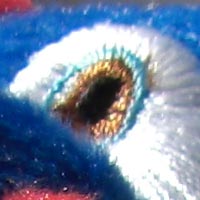Casio EX-V7 Review
Review Date: June 4th 2007
Author: Gavin Stoker
Leave a comment about this Review
|
Image Quality
All of the sample images in this Review were taken using the 7 megapixel mode, which gives an average image size of between 3-5Mb.
Noise
There are 5 ISO settings available on the Casio EX-V7 which you can select at any time if the camera is in the normal shooting mode. Casio's compacts have in the past suffered badly from the bugbear of image noise and, as expected, this starts to creep in from ISO 400, though even at maximum selectable ISO 800 setting it doesn't ruin the shot. In fact I'd go so far as to say the Casio EX-V7 has a better grip on it than previous Exilim generations. Here are some 100% crops which show the noise levels for each ISO setting:
ISO 64 (100% Crop) |
ISO 100 (100% Crop) |
 |
 |
ISO 200 (100% Crop) |
ISO 400 (100% Crop) |
 |
 |
ISO 800 (100% Crop) |
|
 |
|
Sharpening
Here are two 100% Crops which have been Saved as Web - Quality 50 in Photoshop. The right-hand image has had some sharpening applied in Photoshop. The out-of-the camera images are a little soft at the default sharpening setting. Unfortunately you can't change the in-camera sharpening level if you don't like the default look, so you will have to edit the images later.
Original
(100% Crop)
|
Sharpened (100% Crop) |
 |
 |
 |
 |
Chromatic Aberrations
The Casio EX-V7 did suffer from chromatic aberrations during the review, but it was generally well controlled. Limited purple fringing was mainly present around the edges of objects in high-contrast situations, as shown in the examples below.
|
Example
1 (100% Crop)
|
Example
2 (100% Crop)
|
 |
 |
Macro
The Casio EX-V7 offers a Macro setting that allows you to focus on a subject that is 10cms away from the camera when the lens is set to wide-angle. The first image shows how close you can get to the subject (in this case a compact flash card). The second image is a 100% crop.
|
Macro Shot |
Macro Shot (100% Crop) |
 |
 |
Flash
The flash settings on the Casio EX-V7 are Auto, Forced Flash, Slow Syncro and No Flash These shots of a white coloured wall were taken at a distance of 1.5m.
|
No Flash - Wide Angle (38mm) |
Auto Flash - Wide Angle (38mm) |
 |
 |
|
No Flash - Telephoto (266mm) |
Auto Flash - Telephoto (266mm) |
 |
 |
And here are some self-portrait shots. As you can see, both the Flash On setting and the Red-Eye Reduction option caused a noticeable amount of red-eye � undoubtedly down to the fact that the flash bulb is located in the no-no position of directly above the lens.
|
Flash On |
Flash On (100% Crop) |
 |
 |
|
Flash - Red-Eye Reduction |
Flash - Red-Eye Reduction (100% Crop) |
 |
 |
Night Shot
The Casio EX-V7's maximum shutter speed is 60 seconds, which is excellent news if you're seriously interested in night photography. The shot below was taken using a shutter speed of 1/5th second, aperture of f/3.4 at ISO 200. I've included a 100% Crop of the image to show what the quality is like.
|
Night Shot |
Night Shot (100% Crop) |
 |
 |
Overall Image Quality
Like we found with Sony's similarly styled Cyber-shot DSC-T100, locating a lens to the far edge of the Casio EX-V7's front plate means that fingertips can stray into the edges of the frame without being noticed. The likelihood is that if you hand the camera to someone new on holiday for a shot of yourself and the missus, you'll get an image back with a finger sized blob in one corner. Watch out for such possibilities yourself however and you'll be rewarded with sharp, colourful images for the most part � with green foliage coming out particularly vivid, and skin tones embodied with a healthy hue. To be picky I did notice some softness towards the edges of the frame at maximum wide-angle setting, and again, at maximum telephoto images would benefit from some additional sharpening. Results with anti-shake selected are hit and miss, but then no system is 100% infallible and you can at least review the image and fire off another shot if the original doesn't satisfy. Casio's compacts have in the past suffered badly from the bugbear of image noise and, as expected, this starts to creep in from ISO 400, though even at maximum selectable ISO 800 setting it doesn't ruin the shot. In fact I'd go so far as to say the Casio EX-V7 has a better grip on it than previous Exilim generations. It's a different story when it comes to flash however, which inevitably introduces red eye whether the red eye reduction setting is selected or not � undoubtedly down to the fact that the flash bulb is located in the no-no position of directly above the lens. That said, the effects are nowhere as pronounced and unflattering as those delivered by the Sony T100.
|
![]() PhotographyBLOG
is a member of the DIWA
organisation. Our test results for the Casio EX-V7 have been submitted to DIWA
for comparison with test results for different samples of
the same camera model supplied by other DIWA
member sites.
PhotographyBLOG
is a member of the DIWA
organisation. Our test results for the Casio EX-V7 have been submitted to DIWA
for comparison with test results for different samples of
the same camera model supplied by other DIWA
member sites.
